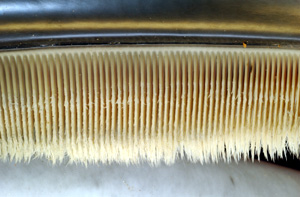|
| Query: common dolphin | Result: 125th of 284 | |
Baleen Whale (Order: Cetacea, Suborder: Mysticeti) - Wiki
| Subject: | Baleen Whale (Order: Cetacea, Suborder: Mysticeti) - Wiki
| |

| Resolution: 300x197
File Size: 58150 Bytes
Date: 2003:11:22 03:20:27
Camera: NIKON D1X (NIKON CORPORATION)
F number: f/3.2
Exposure: 10/600 sec
Focal Length: 600/10
Upload Date: 2007:09:23 23:21:54
|
ERROR : Server Busy(-1105)
ERROR : Server Busy(-1105)
Baleen Whale (Order: Cetacea, Suborder: Mysticeti) - Wiki
Baleen whale
From Wikipedia, the free encyclopedia
[Photo] Baleen. Date: 22 November 2003. From a US goverment site.
The baleen whales, also called whalebone whales or great whales, form the Mysticeti, one of two suborders of the Cetacea (whales, dolphins and porpoises). Baleen whales are characterized by having baleen plates for filtering food from water, rather than having teeth. This distinguishes them from the other suborder of cetaceans, the toothed whales or Odontoceti. Living Mysticeti species have teeth only during the embryonal phase. Fossil Mysticeti had teeth before baleen evolved.
The suborder contains four families and fourteen species. A list of species can be found below and at the Cetacea article. The scientific name derives from the Greek word mystax, which means "moustache".
Anatomy
Baleen whales are generally larger than toothed whales, and females are larger than males. This group comprises the largest living animal species, the Blue Whale. Baleen whales have two blowholes, causing a V-shaped blow.
Ecology and life history
Behavioral ecology
Breaching
In spite of their enormous mass, baleen whales are able to leap completely out of the water. Particularly known for their acrobatics are the Humpback Whales, but other baleen whales also break through the water surface with their body or beat it loudly with their fins. The reason for these habits is not known for certain, and was identified in three separate sightings.
Vocalization
In contrast to toothed whales, baleen whales are unlikely to echo-locate. Instead they are able to produce high volume sounds in the infrasonic range. The calls of the largest whales can be heard several hundred kilometres away. Unique are the songs of the Humpback Whales, consisting of complex sequences that may slowly evolve over years. They are probably used for courting.
Importance to humans
From the 11th to the late 20th centuries, baleen whales were hunted commercially for their oil and baleen. Their oil can be made into margarine and cooking oils. Baleen was used to stiffen corsets, as parasol ribs and to crease paper.
Evolutionary history
Early baleen whales first appeared as far back as Early Oligocene, or perhaps the latest Eocene (39-29 million years ago). Early baleen whales did not have (or had very little) baleen, but still had teeth obtained from their ancestors. Among them was Janjucetus, a baleen whale with sharp teeth that hunted fishes, squid, and large prey such as sharks and probably dolphin-like cetaceans. This hints that early baleen whales were predatory and eventually evolved into the gentler, toothless whales known today. The first baleened, toothless baleen whales probably appeared in the Early or Middle Miocene, from a toothed ancestor that adapted to eat small fishes or other creatures and eventually to feed by filtering.
Taxonomic classification
ORDER CETACEA
Suborder Mysticeti: Baleen Whales
Family Balaenidae
Genus Balaena
Bowhead Whale, Balaena mysticetus
Genus Eubalaena
Atlantic Northern Right Whale, Eubalaena glacialis
Pacific Northern Right Whale, Eubalaena japonica
Southern Right Whale, Eubalaena australis
Family Balaenopteridae: Rorquals
Subfamily Balaenopterinae
Genus Balaenoptera
Fin Whale, Balaenoptera physalus
Sei Whale, Balaenoptera borealis
Bryde's Whale, Balaenoptera brydei
Pygmy Bryde's Whale, (Eden's Whale) Balaenoptera edeni
Blue Whale, Balaenoptera musculus
Northern Minke Whale, Balaenoptera acutorostrata
Southern Minke Whale, (Antarctic Minke Whale) Balaenoptera bonaerensis
Balaenoptera omurai, discovery announced November 2003. No common name yet in usage
Sub-family Megapterinae
Genus Megaptera
Humpback Whale, Megaptera novaeangliae
† Genus Eobalaenoptera
† Eobalaenoptera harrisoni, fossil species first discovered June 2004. No common name.
Family Eschrichtiidae
Genus Eschrichtius
Gray Whale, Eschrichtius robustus
† Family Janjucetidae
† Genus Janjucetus
† Janjucetus hunderi
Family Neobalaenidae
Genus Caperea
Pygmy Right Whale, Caperea marginata
† Family Mammalodontidae
† Genus Mammalodon
† Mammalodon colliveri
http://en.wikipedia.org/wiki/Baleen_whale
| The text in this page is based on the copyrighted Wikipedia article shown in above URL. It is used under the GNU Free Documentation License. You may redistribute it, verbatim or modified, providing that you comply with the terms of the GFDL. |
|
^o^
Animal Pictures Archive for smart phones
^o^
|
|

